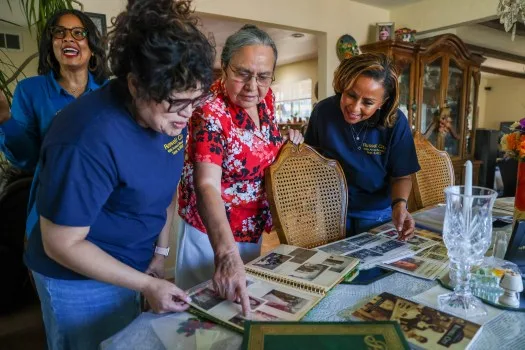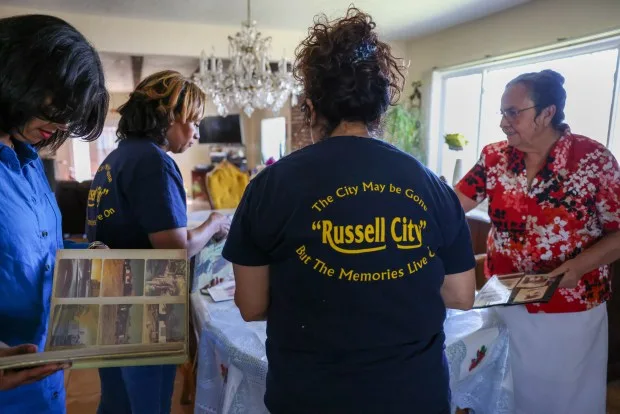
On a recent afternoon, Priscilla Figueroa played “Solamente Una Vez,” a melancholy song about love and loss, on the piano at her home. The music echoed in the dining room, where old photo albums depicted life as it once was in Russell City, a town in which she was married decades earlier. A town where her husband grew up. A town that no longer exists.
“I used to play piano in the churches there,” said Figueroa, 80, who now lives in Hayward.
 Russell City, an unincorporated area in Alameda County, became a thriving haven for people of color after World War II. It was annexed and bulldozed by neighboring Hayward in 1964 to make way for an industrial park, and during the 1950s and 1960s, over 1,400 people were displaced.
Russell City, an unincorporated area in Alameda County, became a thriving haven for people of color after World War II. It was annexed and bulldozed by neighboring Hayward in 1964 to make way for an industrial park, and during the 1950s and 1960s, over 1,400 people were displaced.
Now, nearly 60 years after Russell City was razed, it has become the epicenter of the movement to provide reparations to Black communities in the Bay Area.
Just last month, Alameda County apologized for its role in the destruction of the community, following a similar apology from the city of Hayward in 2021.
A handful of local, state, and county task forces have been meeting to figure out how to make amends for the damage done by Hayward and Alameda County. Figueroa is a member the Russell City Reparative Justice Steering Committee chaired by Aisha Knowles, for whom the incremental steps toward progress stir a kaleidoscope of emotions. Her father grew up in Russell City, and she knows firsthand the pain that was caused by the community’s dissolution.
“It’s a combination of joy, frustration, motivation and a little bit of sadness,” Knowles said of the movement to make amends. “I just wish that so many relatives that weren’t able to experience this had received justice when they were living.”
As the push to compensate Black Americans for hundreds of years of slavery marches forward, Russell City has become shorthand for the ways in which oppression lasted into the modern era.
Many those who moved to Russell City after World War II were escaping housing discrimination they faced in other parts of the Bay Area. But living in the unincorporated area also meant they were left without basic services, including sanitation or a fire department. For years, residents of Russell City asked Alameda County to provide those services, but were denied.
Despite those challenges, the community flourished, and Russell City became known in particular for its vibrant music scene. It had markets, farms, bars and clubs, and blues legends like Ray Charles and Dottie Ivory would regularly perform at venues in town.
That thriving culture did not deter the City of Hayward from declaring Russell City “blighted” in 1964, using eminent domain to annex the community–and ultimately destroy it.
Supervisor Elisa Márquez, who introduced the county’s resolution with Board of Supervisors President Nate Miley, is a lifelong resident of Hayward and grew up hearing about Russell City. To her, the apology was a necessity.
“Speaking to some of the elders, hearing their pain, I did not want to be idle on this,” said Márquez, who represents the District 2 communities of Hayward, Union City, Newark and part of Fremont. “This is the first step, acknowledging the wrongdoing.”
Today, many proponents of restorative justice for Black Americans see Russell City as a prominent example of how the Bay Area can be a leader in the burgeoning reparations movement.
According to Don Tamaki, a member of the state task force on reparations, one of the common arguments against reparations is that slavery ended a long time ago, and no one around today had any part of it. But the events of Russell City, of course, are not ancient history. For Tamaki, they serve as powerful evidence that systems of oppression have persisted.
“After the Civil War ended, the bias and the hate simply morphed into different forms that reverberated through the modern age,” Tamaki said.
Just last month, the California state task force on reparations highlighted Russell City as an example of housing segregation and discriminatory use of eminent domain. It recommended the state restore property “to its original owners or provide another effective remedy…such as restitution or compensation.”
Hayward’s Russell City justice project is expected to present its own report and recommendations before the end of the year. Last winter, Alameda County also created a task force to study reparations.
This tapestry of task forces, recommendations and apologies could manifest as jumble of resolutions without any clear action. But to many observers, the actions surrounding Russell City are tangible steps forward.
“Even though it’s symbolic, this could still begin the healing part and reconciliation,” said Darris Young, the director of organizing for Black Health for the Bay Area Regional Health Inequities Initiative. “Once you admit that it is wrong, then it’s easier to recompense for it.”
Young acknowledged that the process of turning apologies and policy recommendations into actual legislation is an additional hurdle. Many of these initiatives and task forces were formed in the immediate aftermath of George Floyd’s murder in 2020, as protests were sweeping the country. Passing a bill to create a task force that would develop recommendations is much easier than actually spending the money to implement those recommendations.
On a state and national level, conversations about reparations are often weighed down by the sheer enormity of the harm that has been done. Economists have estimated that reparations in California alone would cost upwards of $800 billion, more than two times the state’s annual budget.
Still, Tamaki said, the combination of state, county, and local initiatives working to address the injustices perpetrated in Russell City are proof that the movement toward reparations is gaining momentum.
“Politically, when I look at other movements, they started in the same way,” Tamaki said. “The civil rights movement first focused on policies and laws in specific communities.”
Even as government officials move toward some form of restitution for the descendants of Russell City, there is still an acknowledgment that the community will never return. What was once a bustling, musical area is now covered by industry and a Calpine energy plant. Former residents are getting older, or have passed on. Many of members of the Russell City Reparative Justice Project Steering Committee are now descendants, tasked with figuring out a way to make amends for injustices perpetrated upon their parents and grandparents.
With apologies in hand, the hard task of making amends has already begun.
“I believe I’m one small part of the process that’s helping move it forward on behalf of our families,” Knowles said. “But I’m also part of the process to ensure this doesn’t stop.”











